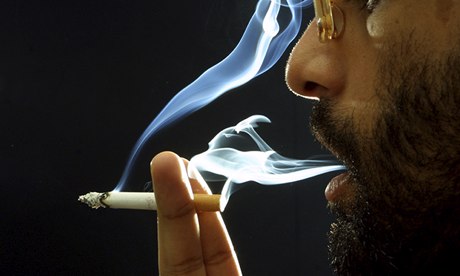An experimental study looks at the possibility of advanced medical treatment for helping smokers fighting their addiction. From Ian Sample of the Guardian:
Heavy smokers who regularly puffed more than a packet of cigarettes a day cut down or quit for six months after their brains were stimulated with magnets, researchers say.
The apparent success of the simple procedure has led the scientists to organise a large-scale trial which will launch early next year at 15 medical centres worldwide.
Smokers in the pilot study had already tried anti-smoking drugs, nicotine gum and patches or psychotherapy to no avail, raising hopes that magnetic stimulation might offer an effective alternative for those who want to give up but have so far failed.
Nearly half of the smokers in one group, who received high-frequency magnetic pulses, quit after a three-week course of stimulation, with more than a third still abstaining six months on.
“This is a new approach to the problem,” said neuroscientist Abraham Zangen of Ben-Gurion University in Israel. “These are heavy smokers who could not stop smoking before.”
The study raises hopes that magnetic stimulation might offer an effective alternative for those who want to give up but have so far failed. (Guardian/Graham Turner)
More trials will be needed to prove the value of the procedure, which scientists say should only be offered within a psychotherapy-based programme designed specifically for smokers.
For the pilot study, Zangen recruited 115 people aged 21-70 who smoked at least 20 a day. Only those who had tried to give up before using at least two methods were allowed to take part in the programme.
The smokers were divided into three groups. The first had 15 minutes of high-frequency magnetic stimulation every weekday for two weeks, followed by three sessions in the third week.
The second group had the same number of sessions of low-frequency magnetic stimulation. The third group thought they were having their brains stimulated, but the device was actually turned off to provide a control group.
Before each session, one of Zangen’s PhD students lit a cigarette and took a puff in front of half of the smokers in each group. This was designed to awaken their cravings for a smoke, and hopefully make them more susceptible to the treatment.
Zangen targeted brain regions called the prefrontal cortex and insula with a technique called deep repeated transcranial magnetic stimulation, or rTMS. Throughout the study, he asked the smokers to record how much they smoked up until six months later.
The results showed a placebo effect, or an improvement without any proper intervention, in the control group, and also in the smokers who received low frequency stimulation. In both of these groups, the smokers cut down on average from 26 to 20 cigarettes a day.
But the results were more impressive in the smokers who had high-frequency brain stimulation after witnessing one of the scientists have a drag on a cigarette: 44% quit after the three-week course and six months later, 36% said they were still not smoking.
To check that the smokers were telling the truth, Zangen tested their urine for a breakdown product of nicotine called cotinine. The results were in line with the smokers’ claims.
Though the findings are promising, the study was too small to be convincing. Zangen said a much larger trial, involving medical centres in several countries, was due to start in the next few months to test the stimulation on far more smokers.
If the procedure turns out to be effective, smokers might not need to have their brains stimulated regularly to avoid relapsing, he said.
“It’s quite easy to quit for a few days, or even for a few weeks, but if we can help people quit for more than three months, then they are actually quite unlikely to relapse later on,” he said.
Peter Eichhammer, who has studied brain stimulation at the University of Regensburg, said that while the procedure might be effective, it was important for smokers to receive treatment in a dedicated psychotherapy-based programme.
“rTMS may help people to reduce smoking, most likely by mimicking nicotine’s actions on the brain reward system,” he said. “But it does not substitute a special psychological therapy. In general, I would be very cautious to promote rTMS as a sole biologically-driven therapeutical strategy.
“rTMS may be helpful but should be embedded in a psychological therapeutical program. Moreover, we need replication from a variety of clinical studies which really treat people with this addiction,” he said.
12 Nov 2013
